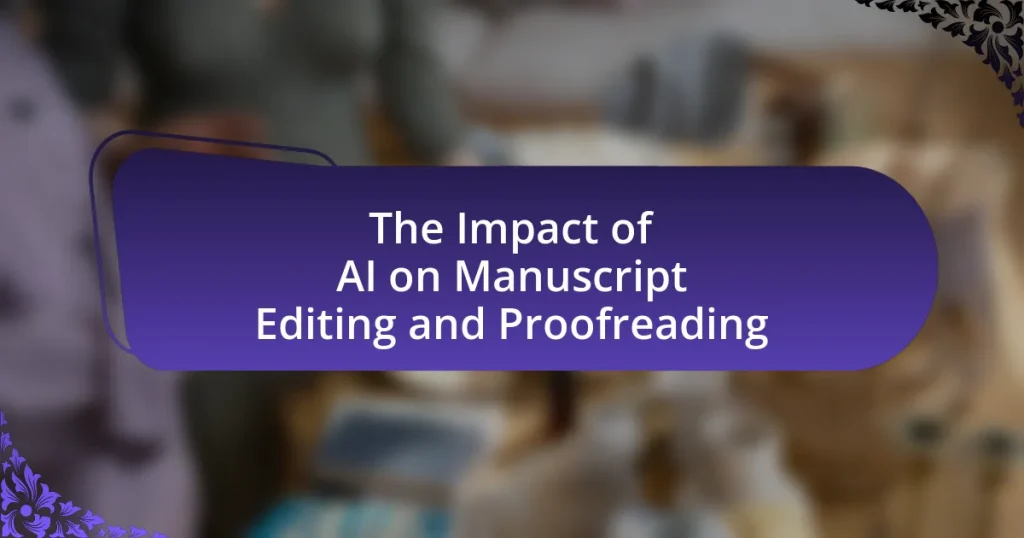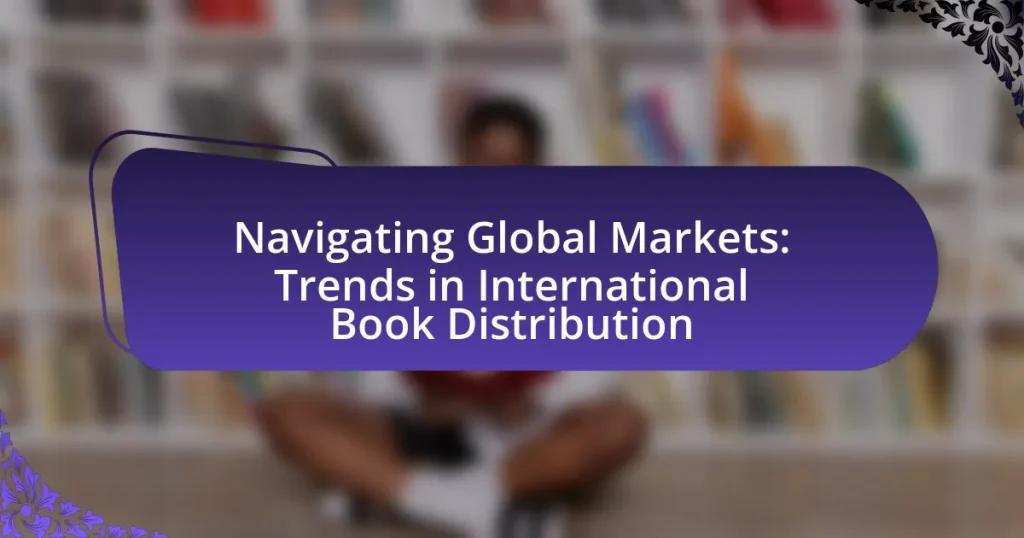Diversity and Inclusion in Publishing refers to the intentional efforts to represent a wide range of voices, perspectives, and backgrounds within the publishing industry, encompassing authors, editors, and marketing professionals. The article explores the importance of diversity and inclusion, highlighting historical challenges, current trends, and the impact of diverse authors on contemporary publishing. It discusses key metrics for measuring diversity initiatives, barriers to achieving greater inclusion, and the role of technology and reader demand in shaping future practices. Additionally, it outlines best practices for publishers to enhance diversity and the economic benefits of embracing diverse narratives in literature.
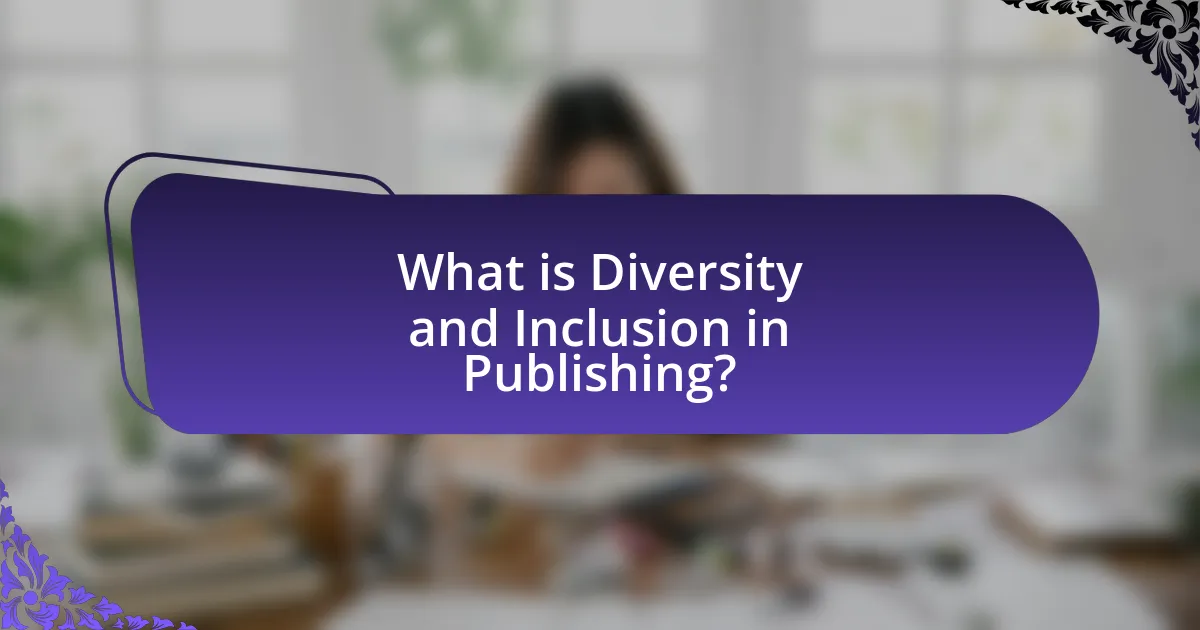
What is Diversity and Inclusion in Publishing?
Diversity and Inclusion in Publishing refers to the intentional efforts to represent a wide range of voices, perspectives, and backgrounds within the publishing industry. This encompasses not only the authors and content being published but also the workforce involved in the publishing process, including editors, agents, and marketing professionals. Research indicates that diverse teams lead to more innovative ideas and better decision-making, as highlighted in a 2018 McKinsey report which found that companies with more diverse workforces are 33% more likely to outperform their peers in profitability. Thus, fostering diversity and inclusion is essential for the growth and relevance of the publishing industry.
Why is Diversity and Inclusion important in the publishing industry?
Diversity and inclusion are crucial in the publishing industry because they enhance creativity, broaden perspectives, and reflect the diverse readership. A diverse workforce leads to a variety of voices and stories, which can resonate with a wider audience. Research by the Cooperative Children’s Book Center indicates that books featuring diverse characters and authors are increasingly sought after, with 28% of children’s books published in 2018 featuring characters of color, up from 22% in 2017. This shift demonstrates the market demand for representation, highlighting that inclusive practices not only fulfill social responsibility but also drive economic success in publishing.
What are the historical challenges faced in achieving diversity in publishing?
Historical challenges in achieving diversity in publishing include systemic biases, lack of representation, and economic barriers. Systemic biases have historically favored white, male authors and editors, leading to a narrow range of voices being published. For instance, a 2019 study by Lee & Low Books found that 76% of children’s books published in 2018 featured white characters, highlighting the lack of diverse representation. Additionally, economic barriers have limited access for marginalized authors, as traditional publishing houses often prioritize established, predominantly white authors due to perceived marketability. This has perpetuated a cycle where diverse voices struggle to gain visibility and support within the industry.
How does inclusion impact the representation of voices in literature?
Inclusion significantly enhances the representation of diverse voices in literature by allowing marginalized perspectives to be heard and validated. This broader representation fosters a richer literary landscape, as it incorporates experiences and narratives that reflect the complexities of society. For instance, studies have shown that diverse authorship leads to a wider array of themes and characters, which can resonate with a more extensive readership. According to the 2019 “Diversity Baseline Survey” conducted by the Authors Guild, only 12% of published authors identified as people of color, highlighting the need for increased inclusion to better reflect societal diversity. By prioritizing inclusion, the literary community can ensure that a multitude of voices contribute to the cultural dialogue, ultimately enriching the reading experience for all.
What are the current trends in Diversity and Inclusion within publishing?
Current trends in Diversity and Inclusion within publishing include a significant push for diverse representation in authorship, editorial teams, and marketing strategies. Publishers are increasingly prioritizing the acquisition of works by underrepresented voices, including authors from various racial, ethnic, and gender backgrounds. For instance, a 2021 report by the Publishers Association indicated that 45% of UK publishers have implemented diversity and inclusion initiatives, reflecting a growing commitment to equitable practices. Additionally, many publishing houses are adopting inclusive hiring practices and creating mentorship programs aimed at supporting marginalized groups within the industry. This trend is further supported by consumer demand for diverse narratives, as studies show that readers are more likely to engage with books that reflect a variety of perspectives and experiences.
How are publishers adapting their practices to promote diversity?
Publishers are adapting their practices to promote diversity by implementing inclusive hiring policies and diversifying their book selections. Many publishing houses are actively seeking to hire individuals from underrepresented backgrounds, which helps to bring varied perspectives into the industry. For instance, a 2021 survey by the Publishers Association found that 45% of publishers have made commitments to improve diversity in their workforce. Additionally, publishers are increasingly prioritizing the acquisition of manuscripts that reflect diverse voices and experiences, as evidenced by initiatives like the #PublishingPaidMe movement, which highlighted pay disparities and encouraged publishers to support authors from marginalized communities. These changes are part of a broader effort to create a more equitable publishing landscape.
What role do diverse authors play in shaping contemporary publishing trends?
Diverse authors play a crucial role in shaping contemporary publishing trends by introducing varied perspectives and narratives that reflect a broader range of human experiences. This inclusion not only enriches the literary landscape but also drives market demand for authenticity and representation, as evidenced by the increase in sales of books by authors from underrepresented backgrounds. According to a 2021 report by the Cooperative Children’s Book Center, only 27% of children’s books published featured diverse characters, highlighting the ongoing need for diverse voices to influence publishing practices. As publishers respond to consumer demand for inclusivity, diverse authors are pivotal in redefining genre boundaries and expanding readership demographics.
What are the key metrics for measuring Diversity and Inclusion in publishing?
Key metrics for measuring Diversity and Inclusion in publishing include demographic representation, employee engagement scores, and retention rates. Demographic representation assesses the diversity of authors, editors, and staff within publishing houses, often analyzed through percentages of various racial, ethnic, and gender identities. Employee engagement scores gauge the inclusivity of workplace culture, typically measured through surveys that evaluate employees’ feelings of belonging and support. Retention rates track the longevity of diverse employees within organizations, indicating whether inclusive practices are effective in maintaining a diverse workforce. These metrics provide quantifiable insights into the effectiveness of diversity and inclusion initiatives in the publishing industry.
How can publishers assess their diversity initiatives effectively?
Publishers can assess their diversity initiatives effectively by implementing measurable metrics and conducting regular evaluations. This involves collecting data on the demographic composition of their workforce, analyzing representation in leadership roles, and reviewing the diversity of authors and content published. For instance, a study by the American Association of Publishers found that organizations with clear diversity metrics are more likely to achieve their diversity goals. Additionally, publishers can utilize employee surveys to gauge perceptions of inclusivity and track progress over time. By establishing benchmarks and comparing results against industry standards, publishers can identify areas for improvement and ensure accountability in their diversity efforts.
What benchmarks exist for evaluating progress in inclusion efforts?
Benchmarks for evaluating progress in inclusion efforts include metrics such as representation ratios, employee engagement surveys, and diversity audits. Representation ratios assess the demographic diversity within an organization compared to industry standards or community demographics, providing a clear picture of inclusivity. Employee engagement surveys measure the perceptions and experiences of employees regarding inclusion, offering qualitative insights into the workplace culture. Diversity audits systematically evaluate policies, practices, and outcomes related to diversity and inclusion, ensuring accountability and identifying areas for improvement. These benchmarks are essential for organizations to track their progress and make informed decisions to enhance inclusion efforts.
How do industry stakeholders influence Diversity and Inclusion in publishing?
Industry stakeholders influence Diversity and Inclusion in publishing by implementing policies, practices, and initiatives that promote equitable representation and access. Publishers, authors, and literary agents actively shape the landscape by prioritizing diverse voices in their acquisitions and marketing strategies. For instance, the #PublishingPaidMe movement highlighted pay disparities among authors of color, prompting many publishers to reassess their compensation structures and commit to more equitable practices. Additionally, organizations like We Need Diverse Books advocate for increased representation in children’s literature, influencing industry standards and encouraging stakeholders to diversify their catalogs. These actions collectively foster a more inclusive publishing environment, demonstrating the significant impact of stakeholders on diversity initiatives.
What are the barriers to achieving greater Diversity and Inclusion in publishing?
The barriers to achieving greater diversity and inclusion in publishing include systemic biases, lack of representation, and limited access to resources. Systemic biases manifest in hiring practices and editorial decisions that favor established voices over underrepresented ones, perpetuating a cycle of exclusion. Lack of representation is evident in both the workforce and the content produced, where marginalized groups are often underrepresented in leadership roles and published works. Limited access to resources, such as funding and mentorship opportunities, further hinders diverse authors and professionals from entering and succeeding in the industry. According to a 2021 report by the Publishers Association, only 14% of publishing employees identify as from a minority ethnic background, highlighting the urgent need for change.
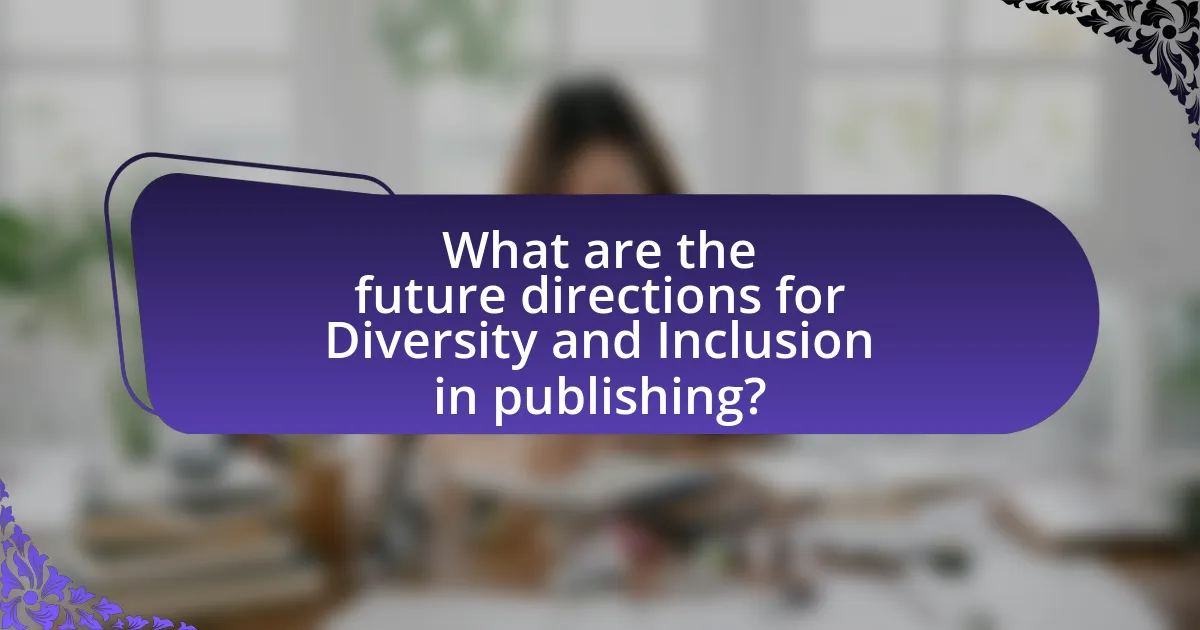
What are the future directions for Diversity and Inclusion in publishing?
The future directions for Diversity and Inclusion in publishing include increasing representation of marginalized voices, implementing equitable hiring practices, and fostering inclusive content creation. Publishers are recognizing the need to diversify their workforce and the narratives they promote, as evidenced by initiatives like the #PublishingPaidMe movement, which highlighted pay disparities and called for transparency. Additionally, industry reports indicate that diverse teams lead to more innovative ideas and better market performance, reinforcing the business case for diversity. As a result, many publishing houses are now prioritizing diversity training and establishing partnerships with organizations that support underrepresented authors, aiming to create a more inclusive literary landscape.
How can technology enhance Diversity and Inclusion efforts in publishing?
Technology can enhance Diversity and Inclusion efforts in publishing by utilizing data analytics and artificial intelligence to identify and address gaps in representation. For instance, algorithms can analyze publishing trends and author demographics, revealing underrepresented voices and genres. A study by the University of Southern California found that diverse teams produce more innovative solutions, which can lead to a broader range of published works. Additionally, digital platforms can facilitate access for marginalized authors, allowing them to reach wider audiences without traditional barriers. This increased accessibility is supported by the rise of self-publishing tools, which empower diverse voices to share their stories directly.
What innovative tools are being used to promote diverse voices?
Innovative tools promoting diverse voices include social media platforms, podcasting, and digital publishing technologies. Social media platforms like Twitter and Instagram enable marginalized voices to reach wider audiences, facilitating grassroots movements and discussions. Podcasting allows underrepresented groups to share their narratives and experiences directly, fostering community engagement and representation. Digital publishing technologies, such as self-publishing platforms and e-books, provide authors from diverse backgrounds with accessible avenues to publish their work without traditional gatekeeping barriers. These tools collectively enhance visibility and representation in the publishing industry, contributing to a more inclusive literary landscape.
How can data analytics inform better diversity practices in publishing?
Data analytics can inform better diversity practices in publishing by providing insights into demographic representation and identifying gaps in inclusivity. By analyzing data on authorship, readership, and content diversity, publishers can assess the current state of representation within their catalogs. For instance, a study by the Cooperative Children’s Book Center found that in 2018, only 28% of children’s books published featured authors of color, highlighting a significant disparity. This data enables publishers to set measurable diversity goals, track progress over time, and implement targeted outreach strategies to underrepresented groups. Furthermore, analytics can help evaluate the effectiveness of diversity initiatives by correlating changes in publishing practices with shifts in audience engagement and sales, thereby reinforcing the importance of data-driven decision-making in fostering an inclusive publishing environment.
What role do readers play in shaping the future of Diversity and Inclusion in publishing?
Readers play a crucial role in shaping the future of Diversity and Inclusion in publishing by influencing market demand for diverse voices and narratives. Their purchasing choices and engagement with diverse content signal to publishers the importance of representation, prompting them to prioritize inclusive practices. For instance, a 2021 survey by the Cooperative Children’s Book Center found that 40% of children’s books published featured characters from diverse backgrounds, reflecting a growing response to reader demand for representation. As readers advocate for more inclusive literature through social media and book clubs, they drive publishers to diversify their catalogs, ultimately fostering a more equitable publishing landscape.
How can reader feedback influence publishing decisions regarding diversity?
Reader feedback can significantly influence publishing decisions regarding diversity by providing insights into audience preferences and expectations. Publishers often analyze feedback to identify gaps in representation and understand which diverse voices resonate with readers. For instance, a study by the Cooperative Children’s Book Center found that books featuring diverse characters increased in popularity when readers expressed a desire for more inclusive narratives. This data-driven approach encourages publishers to prioritize diverse authors and stories, ultimately shaping their catalogs to reflect a broader range of experiences and perspectives.
What impact does consumer demand have on diverse publishing initiatives?
Consumer demand significantly influences diverse publishing initiatives by driving publishers to prioritize inclusive content that reflects a variety of voices and perspectives. As readers increasingly seek representation in literature, publishers respond by expanding their catalogs to include works from underrepresented authors and diverse genres. For instance, a 2021 report from the Cooperative Children’s Book Center indicated that the percentage of children’s books by authors of color rose to 30%, reflecting a direct response to consumer interest in diverse narratives. This shift not only enhances market competitiveness but also fosters a more inclusive literary landscape, aligning with the evolving preferences of a diverse readership.
What best practices can publishers adopt to improve Diversity and Inclusion?
Publishers can improve Diversity and Inclusion by implementing targeted recruitment strategies that prioritize diverse talent. Research shows that diverse teams enhance creativity and decision-making, leading to better business outcomes. For instance, a McKinsey report indicates that companies in the top quartile for gender diversity are 21% more likely to outperform on profitability. Additionally, publishers should establish mentorship programs that support underrepresented voices in the industry, fostering an inclusive culture. Regularly reviewing and revising editorial guidelines to ensure diverse representation in content is also essential, as it directly impacts audience engagement and relevance.
How can mentorship programs support diverse authors in publishing?
Mentorship programs can support diverse authors in publishing by providing guidance, resources, and networking opportunities tailored to their unique challenges. These programs often connect emerging authors with experienced mentors who can offer insights into the publishing process, help refine their writing, and navigate industry barriers. For instance, research from the Association of American Publishers indicates that mentorship initiatives can significantly increase the representation of underrepresented voices in literature, as they foster an environment where diverse authors receive the support needed to succeed. By facilitating access to industry knowledge and professional connections, mentorship programs play a crucial role in promoting diversity and inclusion within the publishing landscape.
What strategies can be implemented to create a more inclusive workplace culture?
To create a more inclusive workplace culture, organizations should implement strategies such as establishing diversity training programs, promoting equitable hiring practices, and fostering open communication. Diversity training programs educate employees about unconscious biases and cultural competencies, which can lead to a more respectful and understanding environment. Research from McKinsey & Company indicates that companies with diverse workforces are 35% more likely to outperform their peers, highlighting the importance of equitable hiring practices that actively seek diverse candidates. Additionally, fostering open communication through regular feedback sessions and inclusive meetings encourages all employees to share their perspectives, thereby enhancing collaboration and innovation.
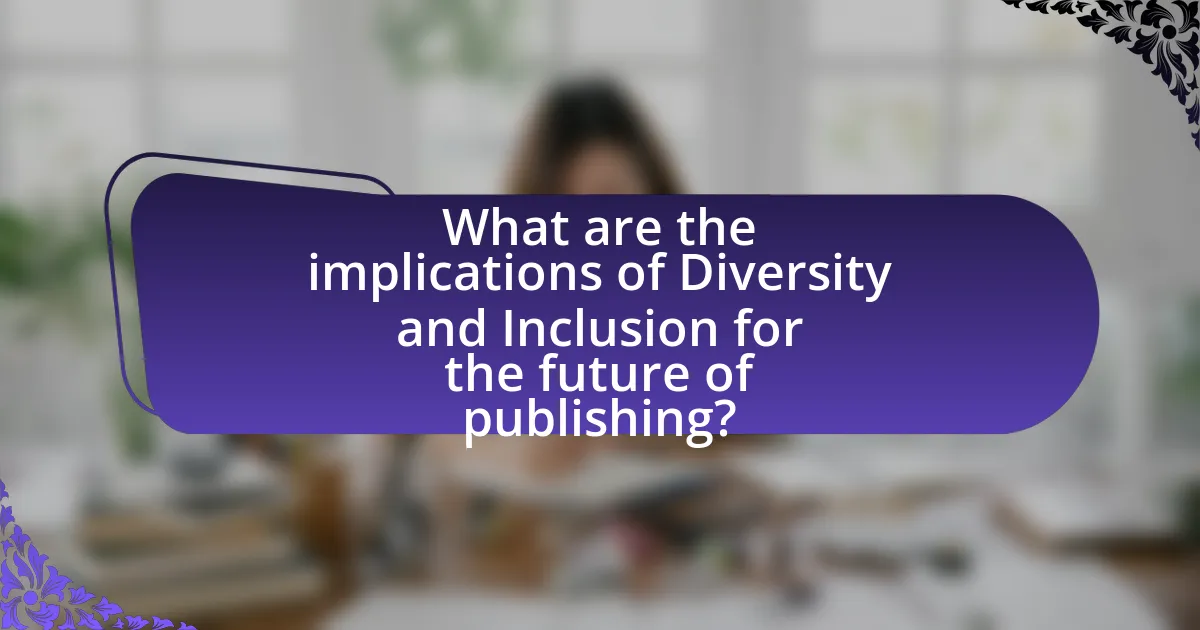
What are the implications of Diversity and Inclusion for the future of publishing?
Diversity and Inclusion will significantly shape the future of publishing by fostering a more representative and equitable industry. As the demographic landscape evolves, publishing companies that prioritize diverse voices and inclusive practices are likely to attract a broader audience, leading to increased readership and sales. Research indicates that diverse teams are more innovative and better at problem-solving, which can enhance the quality of published content. For instance, a study by McKinsey & Company found that companies in the top quartile for gender diversity on executive teams were 21% more likely to experience above-average profitability. This trend suggests that embracing Diversity and Inclusion not only aligns with social responsibility but also drives business success in publishing.
How does Diversity and Inclusion affect the overall success of publishing companies?
Diversity and Inclusion significantly enhance the overall success of publishing companies by fostering creativity, improving market reach, and increasing employee satisfaction. When publishing companies embrace diverse perspectives, they can produce a wider range of content that resonates with various audiences, leading to higher sales and engagement. For instance, a study by McKinsey & Company found that companies in the top quartile for gender and ethnic diversity are 35% more likely to outperform their peers in terms of financial returns. Additionally, inclusive workplaces tend to have higher employee morale and retention rates, which are crucial for maintaining a skilled workforce in the competitive publishing industry.
What are the potential economic benefits of embracing diversity in publishing?
Embracing diversity in publishing can lead to significant economic benefits, including increased market reach and enhanced creativity. Diverse publishing teams are better equipped to understand and cater to a wider audience, which can result in higher sales and market penetration. For instance, a report by McKinsey & Company found that companies with diverse leadership teams are 33% more likely to outperform their peers in profitability. Additionally, diverse perspectives foster innovation, leading to unique content that can attract new readers and expand consumer bases. This economic advantage is further supported by the fact that diverse narratives resonate with underrepresented groups, creating loyal customer segments and driving revenue growth.
How can diverse narratives enrich the literary landscape?
Diverse narratives enrich the literary landscape by introducing a variety of perspectives and experiences that reflect the complexity of human life. This inclusion fosters empathy and understanding among readers, as they encounter stories that challenge their own viewpoints and broaden their cultural awareness. Research indicates that literature featuring diverse voices can lead to increased engagement and interest in reading, particularly among underrepresented groups. For example, a study by the Cooperative Children’s Book Center found that books by and about people of color have seen a significant increase in publication, highlighting a growing recognition of the importance of diverse narratives in literature.
What practical steps can individuals take to advocate for Diversity and Inclusion in publishing?
Individuals can advocate for Diversity and Inclusion in publishing by actively supporting and promoting diverse authors and voices. This can be achieved by seeking out and recommending books from underrepresented groups, participating in or organizing events that highlight diverse literature, and engaging with publishers to encourage them to diversify their catalogs. Research indicates that diverse representation in literature not only enriches the reading experience but also reflects the varied perspectives of society, which is essential for fostering understanding and empathy. For instance, a study by the Cooperative Children’s Book Center found that in 2018, only 28% of children’s books published featured characters of color, highlighting the need for increased advocacy and action in this area.


